
Gelert's Farm Works is the operating centre for the Welsh Highland Heritage Railway (WHHR). It is located in Porthmadog, Wales, and was, as the name suggests, a working farm.

Gelert's Farm Works is the operating centre for the Welsh Highland Heritage Railway (WHHR). It is located in Porthmadog, Wales, and was, as the name suggests, a working farm.
After the WHHR purchased Beddgelert Siding in 1973 from British Rail the ramshackle collection of farm buildings now known as Gelert's Farm came up for sale. The farm, which is situated between Beddgelert Siding and the Cambrian line, was purchased to become the operating centre for the rebuilt Welsh Highland Railway (WHR). After possession of the land was obtained in late 1975 track was laid into the site. Over the next couple of years five sidings were laid into the yard and another back towards Pen-y-Mount. The old hay barn was converted into a locomotive shed and a large pole barn became the Carriage Shed. The stone buildings were converted to workshops and a machine shop.
In 1984 the area between the Carriage Shed and the WHHR main line was cleared and the 'Big Shed', 100 by 40 feet (30 by 12 m), was constructed. The now vacant Carriage Shed was taken over by the Civil Engineer's Department and renamed the Civvies Shed. The yard was remodelled giving four roads (Nos. 1–4) in the Big Shed, two roads into the Civvies Shed (Nos. 5&6), one road into the Loco Shed (No. 7) and a siding (No. 8) alongside the Loco Shed.
The next major development was the construction of the RED[ clarification needed ] Shed north of the main yard alongside Farm Junction. This was in an area of the site known as the Old Man's Area. Between 1990 and 1993 a new shed, 60 by 30 feet (18.3 by 9.1 m), was constructed and fitted out by the Railway Extension Department. Three Sidings (designated A-C) were laid into the new RED Shed (painted grey) and another siding (designated D) was laid alongside the RED Shed. Access was gained from a half lead on No. 8 road alongside the Loco Shed. During this period the shunting neck parallel to the main line was extended to the site of the old trans-shipment wharf where two sidings were laid.
By 2003 the WHHR had decided that its future lay in becoming the heritage centre for the entire WHR. It was realised that more covered accommodation, workshop space and sidings would be needed over the next ten years. The Civvies Shed had ceased to be used as a workshop, had become a depository for junk and was thought to be in imminent danger of collapse. In August 2003 a new siding (No. 9) was laid into the cleared eastern bay of the shed for use as a Wagon repair shop. Over the next six months the roof was repaired and most of the floor concreted. The renamed Carriage & Wagon Workshop (C&W Shop) is now back in use, building and repairing both carriages and wagons.
During June 2005 the north west corner of the C&W Shop was dismantled. One month later during the WHHR's annual Civil's Week the trackwork in front of the Shed was rearranged with two half leads, this resulting in a new siding between the Big Shed and the C&W Shop. The new siding was numbered 5. The two sidings into the C&W Shop were renumbered 6&7. The Loco Shed road was renumbered 8 and the old No. 8 became No. 10. Over the Christmas holiday No. 5 road was extended between the two sheds and alongside the exhibition area. Eventually a new shed (3.4.5 Shed) will cover the exhibition area with Nos. 3&4 roads extended through the back of the Big Shed alongside No. 5 road. No. 6 road was severed alongside the Loco Stores and then slewed 8 ft towards the Joiners Shop and extended 80 ft towards the Cambrian Line. A concrete pad 45 by 10 feet (13.7 by 3.0 m) was laid at the end of the siding for the new Diesel Shed.
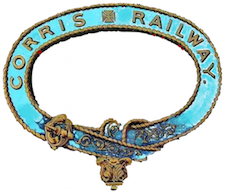
The Corris Railway is a narrow gauge preserved railway based in Corris on the border between Merionethshire and Montgomeryshire in Mid-Wales.

The Welsh Highland Railway (WHR) or Rheilffordd Eryri is a 25-mile (40.2 km) long, restored 1 ft 11+1⁄2 in narrow gauge heritage railway in the Welsh county of Gwynedd, operating from Caernarfon to Porthmadog, and passing through a number of popular tourist destinations including Beddgelert and the Aberglaslyn Pass. At Porthmadog it connects with the Ffestiniog Railway and to the short Welsh Highland Heritage Railway. In Porthmadog it uses the United Kingdom's only mixed gauge flat rail crossing.

The Midland Railway – Butterley is a heritage railway at Butterley, near Ripley in Derbyshire.

The Barry Tourist Railway is a railway developed to attract visitors to Barry in the Vale of Glamorgan, South Wales. It is a key element of the Barry Rail Centre which also includes engineering and training facilities.

Newton Abbot railway station serves the town of Newton Abbot in Devon, England. It is 20 miles 13 chains (32.4 km) down the line from Exeter St Davids and 214 miles 5 chains (344.5 km) measured from London Paddington via Bristol Temple Meads, at the junction for the branch to Paignton. The station today is managed by Great Western Railway, who provide the train service along with CrossCountry.
Wolverhampton railway works was in the city of Wolverhampton in the county of Staffordshire, England. It was almost due north of the city centre, and is commemorated with a small display of level crossing gates and a plaque. Known as the Stafford Road Works, it was opened by the Shrewsbury and Birmingham Railway in 1849 to maintain bought-in locomotives.

Perrygrove Railway is a heritage railway of 15 in gauge. It is located at Perrygrove Farm in the Forest of Dean, near Coleford, Gloucestershire, England. Trains travel at frequent intervals on a round trip of 1+1⁄2 miles (2.4 km) between four stations. Passengers can ride on the train to use activities including a Treetop Adventure, a covered picnic and play area at Foxy Hollow, an Indoor Village with secret passages, and a den-building area in the woods.

Douglas railway station is the main terminus of the Isle of Man Railway and is located at the landward end of the quay in Douglas, the capital of the Isle of Man. It was once the hub for now closed lines to Peel, Ramsey and Foxdale.
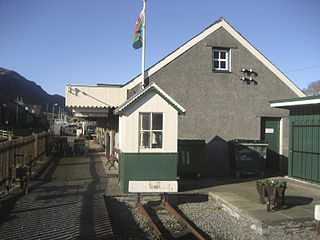
Porthmadog (WHHR) railway station is the southern terminus of the Welsh Highland Heritage Railway and serves the western end of the town of Porthmadog in Gwynedd, Wales. It is situated opposite the Porthmadog National Rail station. The station opened on 2 August 1980 and was originally a simple wooden shed situated in the car park. In January 1986 a portable building was installed at the end of the platforms for use as a waiting room and café.
The restoration of the Welsh Highland Railway has a colourful and complex history. This article provides the modern history.
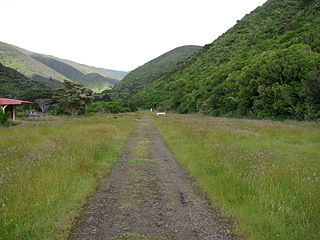
Cross Creek railway station was the base of operations for the Rimutaka Incline, a Fell railway over the Remutaka Ranges, and part of the original Wairarapa Line between Upper Hutt and Featherston in the Wellington region of New Zealand's North Island. The station was between Pigeon Bush and Summit stations on the Wairarapa Line. The station was bypassed when the Rimutaka Tunnel was opened.

Newmarket Workshops in Auckland was a major New Zealand Railways Department facility, one of 13 workshops nationwide. It was one of two main railway workshops of Auckland, used mainly for maintenance; the older facility at Newmarket was replaced in 1929 by Otahuhu Workshops.

The Welsh Highland Heritage Railway is a short reconstructed heritage railway in Gwynedd, Wales. Its main station is in Porthmadog.

North Dorset Railway is a heritage railway based at Shillingstone railway station on the former Somerset and Dorset Joint Railway.

The Cambrian Railways works is a former railway engineering building located in Oswestry, Shropshire.

Broadmeadow Locomotive Depot was a large locomotive depot consisting of two roundhouse buildings and associated facilities constructed by the New South Wales Government Railways adjacent to the marshalling yard on the Main Northern line at Broadmeadow. Construction of the locomotive depot at Broadmeadow commenced in 1923 to replace the existing crowded loco sheds at Woodville Junction at Hamilton, with the depot opening in March 1924. It was added to the New South Wales State Heritage Register on 2 April 1999.
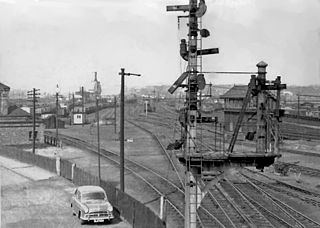
Colwick marshalling yard, also known as Colwick sidings, was a large railway marshalling yard in Netherfield, Nottingham designed for the concentration of coal traffic from the Nottinghamshire and Derbyshire Coalfield for transfer to other marshalling yards in London. It was built by the Great Northern Railway in the triangle formed by the Nottingham-Grantham line, and the Nottingham-Derby line, close to what would become Netherfield and Colwick station. It was built in stages from 1872 and was closed by British Railways in April 1970. The site has now been developed as the Victoria Retail Park.

The Chennai Central–Bangalore City line is an electrified railway double line which connects Chennai and Bangalore, the two largest cities in South India.
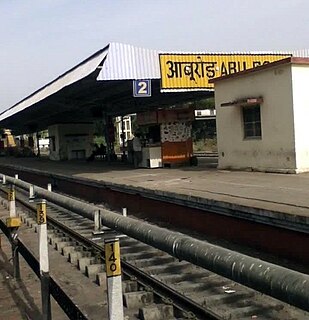
The Jaipur–Ahmedabad line connects Jaipur, the capital of Rajasthan to Ahmedabad, the largest city of Gujarat in India. Swarna Jayanti Rajdhani Express is the fastest train in this route.

Kings Cross Top Shed was a large steam locomotive maintenance and stabling depot just north of King's Cross railway station on the far side of Regent's Canal.